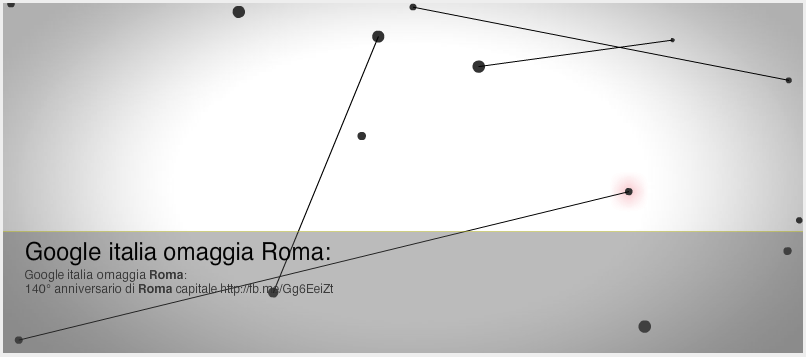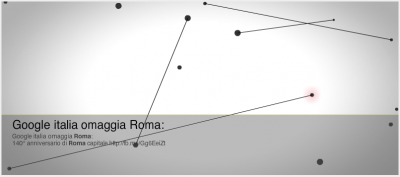Just back from the event held yesterday at the Circolo degli Artisti in Rome, called “Love and Kill Your Own Town”. The event was created by the guys and girls at CityVision Mag in the Wi-Fi Art series of events.
The event featured an incredible set of international projects being showcased using the style called Pecha Kucha, with each presentation being shown using 20 slides automatically moving to the next one after 20 seconds. My personal favourites of the night were maO, featuring some interesting thoughts on interactivity and on letting people define the borders of spaces, Michael Caton, a young designer who presented a software/photography project showing the “backstage” of the colossal architectural building grounds in Dubai and the rough condition of their workers, Weekend in a Morning, who presented a beautifully surreal and poetic project in which the traffic situation in Rome was confronted by designing an air transportation system using hot-air balloons from the borders of the city, and 2A+P/A, with their wonderful project about the productive condos in which a housign system was integrated with facilities for urban gardening, energy production and all sorts of activities that implement a sustainable living scheme. But all the projects were really interesting in proposing views on the city that created alternative interpretations of given reality, discovering how architectures could describe new forms of life either by suggesting – through spaces, materials and what you can do with them – different ways of living – more sustainable, more sensible to people and the environment and, most of all, intriducing the possibility for people to decide what to do with their spaces – or by doing it first-hand, following processes in which human beings, their self determination and their expression, are the most valuable thing that is taken into account.
At the event we presented two things: a project featuring wide sensing techniques to publish the stories of cities, and what we called the Atlante di Roma.
The first: Cities tell stories
this are the presentation slides we used:
As you can see by following the slides we told the story of how we gave thousands of people electronic devices capable of generating info and bio feedback, and combining this information with other sources to generate visual narratives of the city.
We chose 3 persons among the thousands and we created a story. On each person’s callout you can see the red bar, showing heartbeat rate, the blue bar showing stress conditions as gathered from galvanic skin response feedback, and the green bar showing emotional arousal information as collected from the interface of a mobile application that was given to them together with the devices.
The story followed the life of the three characters, describing a little urban love story, in which the sensors, traffic conditions, CO2 production, and mobile traffic profile of the the characters effectively created a time-based infoaesthetic tale.
The project was fake.
Together with FakePress we did similar projects and many people all over the world are currently creating and researching on these themes, making them more and more actual and feasable every day. So the fact that we presented a fake project is not really a big deal :) (and, halfway through the presentation we actually told people, and justified using the argumentation that I will use in a coule of lines or so)
We presented a fake project because it was probabily more real than any project presentation that we could have made.
Project presentations can be done in several ways: be them poetic, minimalistic, corporate… But, mostly, they represent only a single point of view. A single, incomplete, point of view.
So they do not represent, in any way, reality (or, at least, some indefinable, absolute “thing” that some people may have the temptation to call “reality”) which is, by definition, an interactive cohexistence of multiple points of view.
So we decided that it would be more significative to tell a lie, to describe a fake project, but, while doing this, to describe our perspective on the world and to delegate the discussion of our peojects to the projects themselves, that can be experienced online, used on mobile phones and even worn, in the case of our wearable technologies.
The second thing that we did during the event was to present one of these projects, in total adherence to what we described in the fake project presented with the slideshows. So, after all, it was not a fake. or, better, the presentation was a fake that described a real thing, so that the real thing could be more understandable. And, actually, it was fantastic how people believed more in the fake than in my expanations of the real project presented, which I will give you all a few lines below.
the project was presented as Atlante di Roma, but, after the presentation, it should actually be called “ConnectiCity“.
Let’s see why.
Atlante di Roma was an extraordinary architectural installation that we have been invited to create by Paolo Valente, the curator, for the Index Urbis Festa dell’Architettura in Rome. The installation featured a large-scale urban screen (about 35 meters long) that enacted a series of generative interfaces through which the visions on the city produced by institutions, organizations, studios and single individuals could be navigated using multitouch technologies, across space, time and subjects. The installation was though as something that could remain persistent, with an information system feeding its information that in a first phase (the one for the event) would have been fed by the responsibles of the organizations involved, but that would have been opened to public access so that anyone could express their vision on the city by uploading text, multimedia and their own voices.
Apart from the ever-present technical problems and some adjustments and changes in the interactivity that, after seeing it in action, we all agreed, together with Paolo, were needed, the Atlas perfectly did its job. And the online version is still working (if quite unattended, while we gather our forces and funds to keep the project going), and ready to be reproduced here in Rome and in other parts of the world.
What we presented at the event was something different.
You can see a scaled down version of the software used for the installation here at ConnectiCity: the City tells its stories
The concept shows a prottype for an urban screen that collects in realtime all the information generated by citizens on social networks and discussing their city, radiating outward from its geographical position. Imagine the screen placed in a neighborhood: walking by, you would could read what the people there, in that instant are saying about their city.
It is a way to communicate the multiple perspectives that effectively build the city, creating an architecture on top of it made from emotion, imagination, desires, ambitions and fears, and to make them part of the architectural landscape.
We decided to call this new concept using another name: ConnectiCity.
Atlas and ConnectiCity are two different things, thay have different objectives: the Atlas is a system that allows to create an environment with a specific form that is used to represent the visions on the city in which it is placed (as the Atlas of Rome does for Rome); ConnectiCity is a stream of consciusness, a situated collective stream of ideas, projects, visions and emotions emerging in a specific area thanks to whoever decides to express. While the Atlas focuses on the creation of a form, ConnectiCity focuses on the creation of a process.
Both share a vision: to create architectural spaces in cities that are dedicated to expression, emotion, and self-determination, tolerance, multi-culturalism.
![[ AOS ] Art is Open Source](https://www.artisopensource.net/network/artisopensource/wp-content/uploads/2020/03/AOSLogo-01.png)

